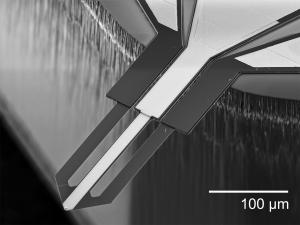Home > Press > Researchers measure nanometer scale temperature: Nanometer scale temperature
 |
| This is an electrothermal cantilever from the University of Illinois, having nanometer-scale electrode tip integrated onto a microheater.
Credit: University of Illinois at Urbana-Champaign |
Abstract:
Atomic force microscope cantilever tips with integrated heaters are widely used to characterize polymer films in electronics and optical devices, pharmaceuticals, paints, and coatings. These heated tips are also used in research labs to explore new ideas in nanolithography and data storage, and to study fundamentals of nanometer-scale heat flow. Until now, however, no one has used a heated nano-tip for electronic measurements.
Researchers measure nanometer scale temperature: Nanometer scale temperature
Urbana, IL | Posted on December 19th, 2011"We have developed a new kind of electro-thermal nanoprobe," according to William King, a College of Engineering Bliss Professor in the Department of Mechanical Science and Engineering at the University of Illinois at Urbana-Champaign. "Our electro-thermal nanoprobe can independently control voltage and temperature at a nanometer-scale point contact. It can also measure the temperature-dependent voltage at a nanometer-scale point contact."
"Our goal is to perform electro-thermal measurements at the nanometer scale," according to Patrick Fletcher, first author of the paper, "Thermoelectric voltage at a nanometer-scale heated tip point contact," published in the journal Nanotechnology. "Our electro-thermal nanoprobe can be used to measure the nanometer-scale properties of materials such as semiconductors, thermoelectrics, and ferroelectrics."
The electro-thermal probes are different than thermal nanoprobes typically used in King's group and elsewhere. They have three electrical paths to the cantilever tip. Two of the paths carry heating current, while the third allows the nanometer-scale electrical measurement. The two electrical paths are separated by a diode junction fabricated into the tip. While the cantilever design is complex, the probes can be used in any atomic force microscope.
In addition to Fletcher, co-authors of the paper include Byeonghee Lee, and William King. The research was performed in the Nanoengineering laboratory as well as the Micro and Nanotechnology Laboratory and the Materials Research Laboratory at the University of Illinois.
The paper is available online at doi:10.1088/0957-4484/23/3/035401
The research was sponsored by the Office of Naval Research and the Air Force Office of Scientific Research.
####
For more information, please click here
Contacts:
William King
217-244-3864
Copyright © University of Illinois College of Engineering
If you have a comment, please Contact us.Issuers of news releases, not 7th Wave, Inc. or Nanotechnology Now, are solely responsible for the accuracy of the content.
| Related News Press |
News and information
![]() Researchers develop molecular qubits that communicate at telecom frequencies October 3rd, 2025
Researchers develop molecular qubits that communicate at telecom frequencies October 3rd, 2025
![]() Next-generation quantum communication October 3rd, 2025
Next-generation quantum communication October 3rd, 2025
![]() "Nanoreactor" cage uses visible light for catalytic and ultra-selective cross-cycloadditions October 3rd, 2025
"Nanoreactor" cage uses visible light for catalytic and ultra-selective cross-cycloadditions October 3rd, 2025
Govt.-Legislation/Regulation/Funding/Policy
![]() New imaging approach transforms study of bacterial biofilms August 8th, 2025
New imaging approach transforms study of bacterial biofilms August 8th, 2025
![]() Electrifying results shed light on graphene foam as a potential material for lab grown cartilage June 6th, 2025
Electrifying results shed light on graphene foam as a potential material for lab grown cartilage June 6th, 2025
![]() Institute for Nanoscience hosts annual proposal planning meeting May 16th, 2025
Institute for Nanoscience hosts annual proposal planning meeting May 16th, 2025
Discoveries
![]() Researchers develop molecular qubits that communicate at telecom frequencies October 3rd, 2025
Researchers develop molecular qubits that communicate at telecom frequencies October 3rd, 2025
![]() Next-generation quantum communication October 3rd, 2025
Next-generation quantum communication October 3rd, 2025
![]() "Nanoreactor" cage uses visible light for catalytic and ultra-selective cross-cycloadditions October 3rd, 2025
"Nanoreactor" cage uses visible light for catalytic and ultra-selective cross-cycloadditions October 3rd, 2025
Announcements
![]() Rice membrane extracts lithium from brines with greater speed, less waste October 3rd, 2025
Rice membrane extracts lithium from brines with greater speed, less waste October 3rd, 2025
![]() Researchers develop molecular qubits that communicate at telecom frequencies October 3rd, 2025
Researchers develop molecular qubits that communicate at telecom frequencies October 3rd, 2025
![]() Next-generation quantum communication October 3rd, 2025
Next-generation quantum communication October 3rd, 2025
![]() "Nanoreactor" cage uses visible light for catalytic and ultra-selective cross-cycloadditions October 3rd, 2025
"Nanoreactor" cage uses visible light for catalytic and ultra-selective cross-cycloadditions October 3rd, 2025
Tools
![]() Japan launches fully domestically produced quantum computer: Expo visitors to experience quantum computing firsthand August 8th, 2025
Japan launches fully domestically produced quantum computer: Expo visitors to experience quantum computing firsthand August 8th, 2025
![]() Rice researchers harness gravity to create low-cost device for rapid cell analysis February 28th, 2025
Rice researchers harness gravity to create low-cost device for rapid cell analysis February 28th, 2025
Military
![]() Quantum engineers ‘squeeze’ laser frequency combs to make more sensitive gas sensors January 17th, 2025
Quantum engineers ‘squeeze’ laser frequency combs to make more sensitive gas sensors January 17th, 2025
![]() Chainmail-like material could be the future of armor: First 2D mechanically interlocked polymer exhibits exceptional flexibility and strength January 17th, 2025
Chainmail-like material could be the future of armor: First 2D mechanically interlocked polymer exhibits exceptional flexibility and strength January 17th, 2025
![]() Single atoms show their true color July 5th, 2024
Single atoms show their true color July 5th, 2024
![]() NRL charters Navy’s quantum inertial navigation path to reduce drift April 5th, 2024
NRL charters Navy’s quantum inertial navigation path to reduce drift April 5th, 2024
|
|
||
|
|
||
| The latest news from around the world, FREE | ||
|
|
||
|
|
||
| Premium Products | ||
|
|
||
|
Only the news you want to read!
Learn More |
||
|
|
||
|
Full-service, expert consulting
Learn More |
||
|
|
||








